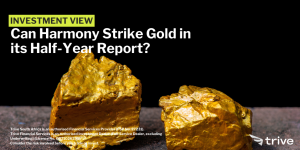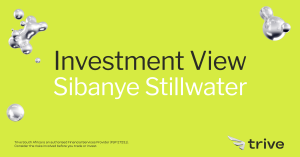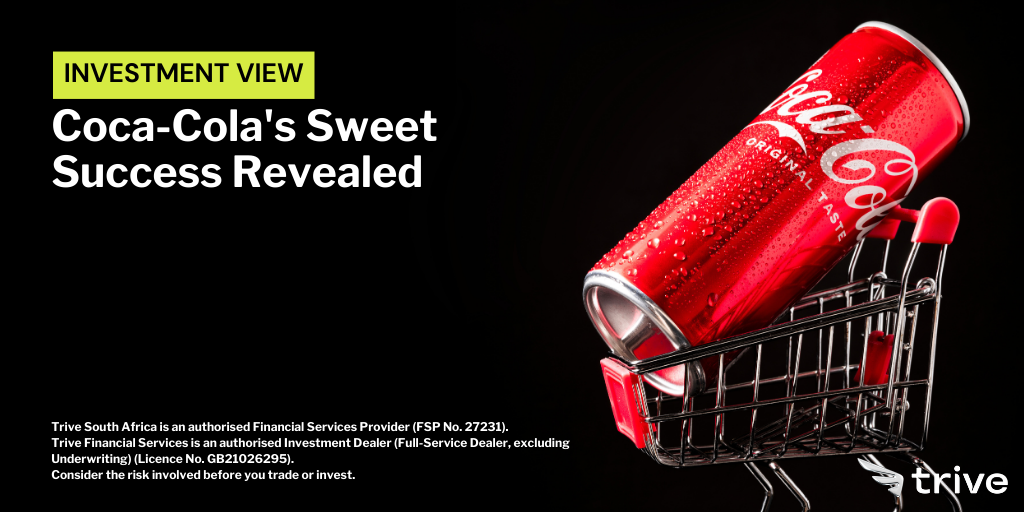
The Coca-Cola Company (NYSE: KO) has captivated investors’ interest with the unveiling of its fourth-quarter earnings release. In the lead-up to this moment, market chatter swirled around the potential performance of this globally renowned soft drink giant.
Despite its esteemed brand value and a diverse array of beverages, concerns have recently lingered regarding the growing consumer demand for healthier options, contrasting with the company’s traditional sugary drinks. The escalating popularity of weight loss drugs like Ozempic from Novo Nordisk and Mounjaro from Eli Lilly amplified this concern. So, before delving into the earnings release, let’s explore the company’s financial stance in the market through the lens of investors leading up to the report.
Technical
On the daily chart, an ascending channel was in play leading up to the earnings release. The 50-SMA (blue line) offered support at the lower end, while the 25-SMA (green line) has established resistance not far above.
If the price opens lower, the 61.8% Fibonacci golden ratio could be the first hurdle to the breakdown at $58.82. A pivot could occur here to potentially reverse the selloff. However, if the bearish momentum is sustained, the trend reversal could be confirmed with a move down to $58.05. The 100-SMA (orange line) trends not far above the Fibonacci midpoint, marking a psychological support zone near $57.44, where a retracement could kick off.
However, a break above the resistance of $60.46 could be on if the price opens higher. This move could see a continuation of the ascending channel, while higher resistance at $61.39 offers a different challenge. If this resistance gets breached, the uptrend could steepen, bringing $62.10 and the supply zone at $63.33 into play in the upcoming days.

Fundamental
Over the past year, Coca-Cola’s stock price has seen minimal movement, as seen in the chart below, increasing by a marginal 0.13%. Although surpassing its main rival, Pepsi, which experienced a decrease of 3.11%, this growth falls short compared to the broader US equity market. During this time frame, the Nasdaq 100 and S&P 500 surged by 46% and 23%, respectively, fuelled by optimism surrounding the technology sector. As inflation reaches its peak and expectations of Federal Reserve interest rate cuts loom, investors, are shifting focus towards cyclical stocks to capitalize on the ongoing bullish market and potential recovery in the US economy following the recent inflation surge. In this evolving landscape, where does Coca-Cola stand?
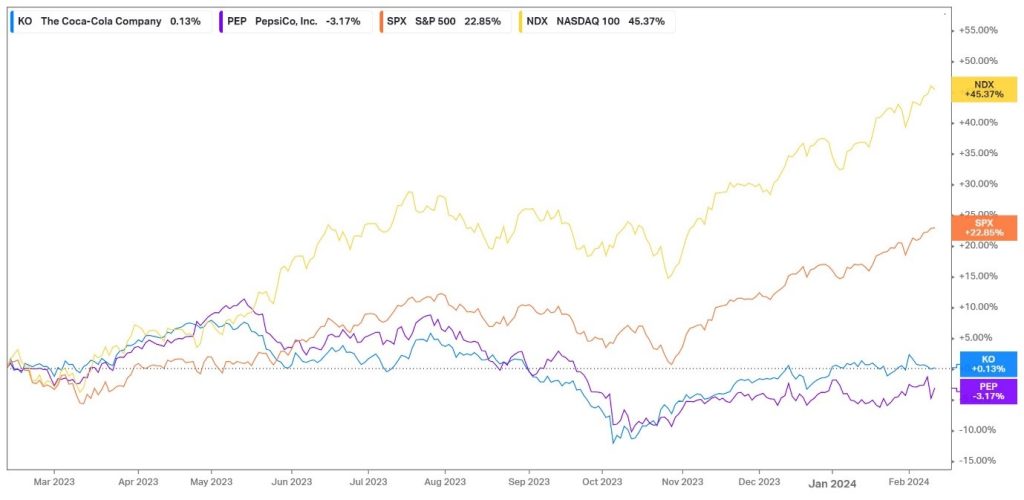
Let’s start by highlighting the distinctive traits of Coca-Cola’s stock. Coca-Cola isn’t known for its rapid price swings; instead, it’s celebrated for its steadfastness amidst market ups and downs. This stability stems from its consistent cash flows and earnings, driven by a proven business model. Its Beta exposure, depicted in the graph below, sheds light on its resilience. With a Beta of 0.38, Coca-Cola stands out as not only less volatile than the S&P 500 but also than recent stock market standouts like Nvidia (1.96), Meta (1.74), and Google (1.31), which show higher volatility. While it may not deliver sky-high share price jumps, Coca-Cola holds its ground in investment portfolios thanks to its adeptness in navigating uncertainty. Consider this: during the volatility spike of 2018 between September and December, a portfolio holding only Pepsi and Coca-Cola would have barely budged, declining by just 0.55%. Meanwhile, the S&P 500 tumbled over 17%, and a three-stock portfolio of Meta, Google, and Nvidia nosedived by nearly 31%. Likewise, amid the inflation surge of 2022 from January to October, the S&P 500 plummeted by 25.36%, while the three-stock portfolio suffered a loss exceeding 52%. Yet, the two-stock Pepsi and Coke portfolio saw a mere 2.37% decline, illustrating its potential value in a portfolio.
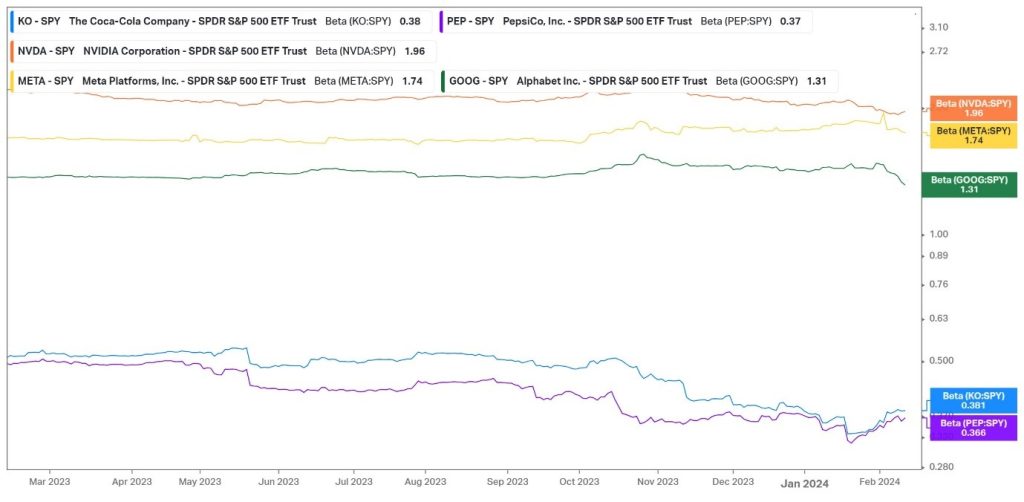
While navigating market ups and downs is crucial, investors also seek returns on their investments, and Coca-Cola delivers on this front, too. Renowned for its consistent dividend increases spanning over 60 years, the company offers a dividend yield exceeding 3%, surpassing the S&P 500 average twofold. These attributes have propelled Coca-Cola to become the fourth largest holding in Warren Buffet’s Berkshire Hathaway portfolio, boasting a hefty 9.23% stake. The advantages of these robust dividends in a long-term portfolio are evident in the graph below. Over the past decade, Coca-Cola’s stock price has appreciated by nearly 55%. However, when factoring in dividends, the total return on the stock exceeds 112%, doubling the price return alone. This track record underscores Coca-Cola’s ability to shield itself against significant market fluctuations while its resilient business model consistently generates ample free cash flow to sustain generous dividend payouts, making it a compelling choice for value investors historically.
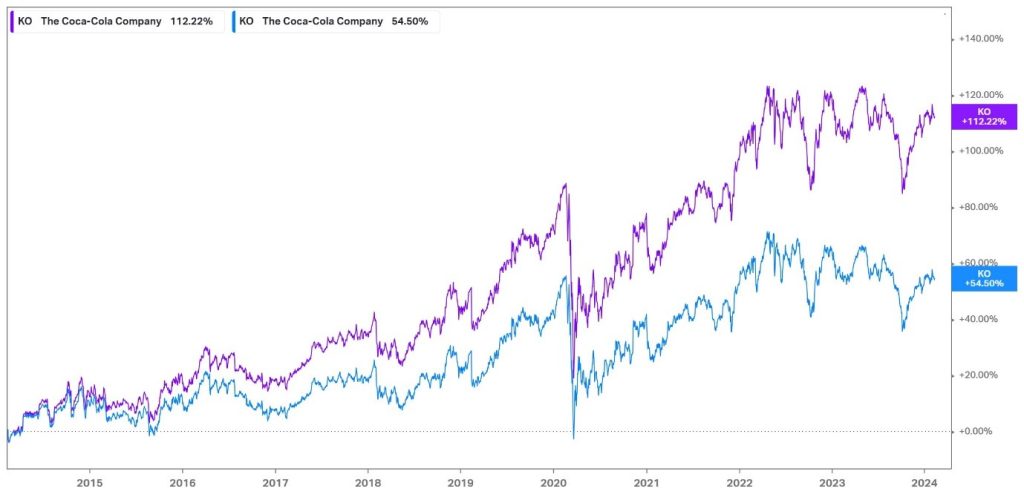
With that being said, let’s delve into the latest earnings. Coca-Cola delivered a double beat in its latest quarterly earnings as revenue grew by 7% from the year-ago period to $10.8Bn, exceeding the $10.67Bn estimates. Organic revenues were up by 12%, driven by a 9% improvement in price/mix and a 3% growth in concentrate sales. Its non-GAAP earnings per share (EPS) expanded by 10% to $0.49, surpassing the estimates of $0.489. Overall unit case volumes for the quarter were up by 2%, driven by a 4% expansion in Latin America. In developed markets, growth in Mexico and Germany was offset by declines in Chile and the US. Sparkling soft drinks were up 2% for the quarter, with its trademark Coca-Cola beverage growing by 2%, while its Coca-Cola Zero Sugar beverage saw a 4% uptick in unit case volumes. The company also acknowledged gaining market share in total non-alcoholic ready-to-drink (NARTD) beverages for the quarter and the full year.
Once again, these numbers do not exhibit the rapid growth seen in some technology companies that are leveraging the lucrative benefits of AI. Still, it continues to showcase slow and steady growth regardless of the macroeconomic environment. This is further shown in the outlook for the 2024 fiscal year, where management expects organic revenue to grow by 6%-7%, which could trickle down into non-GAAP EPS growth of 4%-5% in the upcoming year. The continuous growth of its earnings and free cash flow, predicted to come in at $9.2Bn in the upcoming year, will continue to support its ongoing dividend payments, which could satisfy shareholders looking for an income return.
Summary
The Coca-Cola Company is well renowned for its iconic soft drink brand but not so much for its lucrative returns in the stock market. However, it provides a certain element of safety in a portfolio, with its ability to easily navigate macroeconomic uncertainty through its impressive free cash flow generation and steady earnings growth that continues to support the lucrative dividend payouts that its investors yearn for. Its latest earnings report showcased a double beat, reflecting the company’s ongoing ability to sustainably maintain its steady trajectory.
Sources: Koyfin, Tradingview, Reuters, The Coca-Cola Company
Piece written by Tiaan van Aswegen, Trive Financial Market Analyst
Disclaimer: Trive South Africa (Pty) Ltd (hereinafter referred to as “Trive SA”), with registration number 2005/011130/07, is an authorised Financial Services Provider in terms of the Financial Advisory and Intermediary Services Act, 37 of 2002. Trive SA is authorised and regulated by the South African Financial Sector Conduct Authority (FSCA) and holds FSP number 27231. Trive Financial Services Ltd (hereinafter referred to as “Trive MU”) holds an Investment Dealer (Full-Service Dealer, excluding Underwriting) Licence with licence number GB21026295 pursuant to section 29 of the Securities Act 2005, Rule 4 of the Securities Rules 2007, and the Financial Services Rules 2008. Trive MU is authorized and regulated by the Mauritius Financial Services Commission (FSC) and holds Global Business Licence number GB21026295 under Section 72(6) of the Financial Services Act. Trive SA and Trive MU are collectively known and referred to as “Trive Africa”.
Market and economic conditions are subject to sudden change which may have a material impact on the outcome of financial instruments and may not be suitable for all investors. Trive Africa and its employees assume no liability for any loss or damage (direct, indirect, consequential, or inconsequential) that may be suffered. Please consider the risks involved before you trade or invest. All trades on the Trive Africa platform are subject to the legal terms and conditions to which you agree to be bound. Brand Logos are owned by the respective companies and not by Trive Africa. The use of a company’s brand logo does not represent an endorsement of Trive Africa by the company, nor an endorsement of the company by Trive Africa, nor does it necessarily imply any contractual relationship. Images are for illustrative purposes only and past performance is not necessarily an indication of future performance. No services are offered to stateless persons, persons under the age of 18 years, persons and/or residents of sanctioned countries or any other jurisdiction where the distribution of leveraged instruments is prohibited, and citizens of any state or country where it may be against the law of that country to trade with a South African and/or Mauritius based company and/or where the services are not made available by Trive Africa to hold an account with us. In any case, above all, it is your responsibility to avoid contravening any legislation in the country from where you are at the time.
CFDs and other margin products are complex instruments and come with a high risk of losing money rapidly due to leverage. You should consider whether you understand how these products work and whether you can afford to take the high risk of losing your money. Professional clients can lose more than they deposit. See our full Risk Disclosure and Terms of Business for further details. Some or all of the services and products are not offered to citizens or residents of certain jurisdictions where international sanctions or local regulatory requirements restrict or prohibit them.


